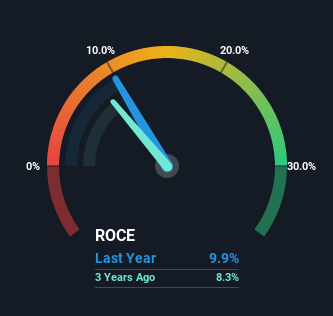
What are the early trends we should look for to identify a stock that could multiply in value over the long term? Firstly, we'd want to identify a growing return on capital employed (ROCE) and then alongside that, an ever-increasing base of capital employed. Put simply, these types of businesses are compounding machines, meaning they are continually reinvesting their earnings at ever-higher rates of return. In light of that, when we looked at IMC (WSE:IMC) and its ROCE trend, we weren't exactly thrilled.
What Is Return On Capital Employed (ROCE)?
Just to clarify if you're unsure, ROCE is a metric for evaluating how much pre-tax income (in percentage terms) a company earns on the capital invested in its business. Analysts use this formula to calculate it for IMC:
Return on Capital Employed = Earnings Before Interest and Tax (EBIT) ÷ (Total Assets - Current Liabilities)
0.099 = US$29m ÷ (US$345m - US$56m) (Based on the trailing twelve months to September 2022).
Therefore, IMC has an ROCE of 9.9%. In absolute terms, that's a low return and it also under-performs the Food industry average of 18%.
Check out our latest analysis for IMC

Historical performance is a great place to start when researching a stock so above you can see the gauge for IMC's ROCE against it's prior returns. If you'd like to look at how IMC has performed in the past in other metrics, you can view this free graph of past earnings, revenue and cash flow.
So How Is IMC's ROCE Trending?
In terms of IMC's historical ROCE movements, the trend isn't fantastic. Around five years ago the returns on capital were 26%, but since then they've fallen to 9.9%. And considering revenue has dropped while employing more capital, we'd be cautious. This could mean that the business is losing its competitive advantage or market share, because while more money is being put into ventures, it's actually producing a lower return - "less bang for their buck" per se.
On a side note, IMC has done well to pay down its current liabilities to 16% of total assets. So we could link some of this to the decrease in ROCE. Effectively this means their suppliers or short-term creditors are funding less of the business, which reduces some elements of risk. Some would claim this reduces the business' efficiency at generating ROCE since it is now funding more of the operations with its own money.
What We Can Learn From IMC's ROCE
In summary, we're somewhat concerned by IMC's diminishing returns on increasing amounts of capital. However the stock has delivered a 99% return to shareholders over the last five years, so investors might be expecting the trends to turn around. In any case, the current underlying trends don't bode well for long term performance so unless they reverse, we'd start looking elsewhere.
Like most companies, IMC does come with some risks, and we've found 3 warning signs that you should be aware of.
While IMC may not currently earn the highest returns, we've compiled a list of companies that currently earn more than 25% return on equity. Check out this free list here.
New: AI Stock Screener & Alerts
Our new AI Stock Screener scans the market every day to uncover opportunities.
• Dividend Powerhouses (3%+ Yield)
• Undervalued Small Caps with Insider Buying
• High growth Tech and AI Companies
Or build your own from over 50 metrics.
Have feedback on this article? Concerned about the content? Get in touch with us directly. Alternatively, email editorial-team (at) simplywallst.com.
This article by Simply Wall St is general in nature. We provide commentary based on historical data and analyst forecasts only using an unbiased methodology and our articles are not intended to be financial advice. It does not constitute a recommendation to buy or sell any stock, and does not take account of your objectives, or your financial situation. We aim to bring you long-term focused analysis driven by fundamental data. Note that our analysis may not factor in the latest price-sensitive company announcements or qualitative material. Simply Wall St has no position in any stocks mentioned.
About WSE:IMC
IMC
Operates as an integrated agricultural company in Ukraine and internationally.
Flawless balance sheet and good value.
Market Insights
Community Narratives



